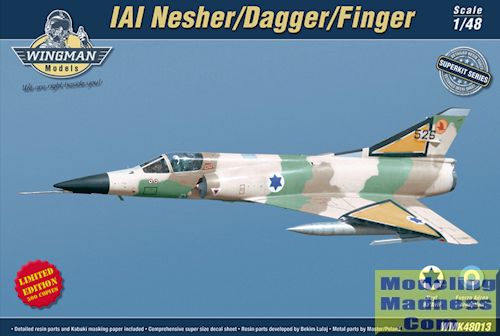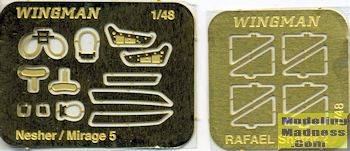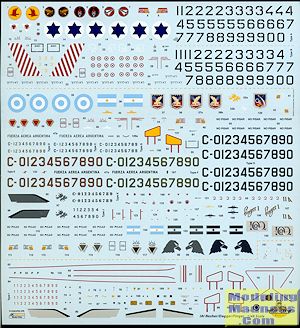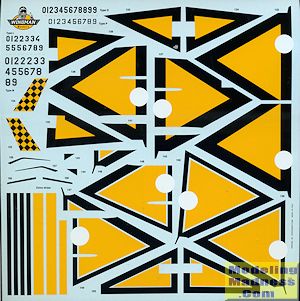
Wingman Models 1/48 Nesher/Dagger/Finger
| KIT #: | 48013 |
| PRICE: | 70.Euros |
| DECALS: | Multiple options |
| REVIEWER: | Scott Van Aken |
| NOTES: | Multimedia kit with resin and photo etch. |

| HISTORY |
The Israel Aircraft Industries Nesher (Hebrew: נשר, "Vulture" - often mistranslated as "Eagle") is the Israeli version of the Dassault Mirage 5 multi-role fighter aircraft. Most were later sold to the Argentine Air Force as Daggers, and later upgraded as Fingers.
Israel had to replace more than 60 aircraft lost during the Six Day War and the War of Attrition which followed. Before the war, Israel began co-development with Dassault to build the Mirage 5 and it was eventually built by Israel and named Raam in Hebrew (thunder).
Dassault Aviation had developed the Mirage 5 at the request of the Israelis, who were the main foreign customers of the Mirage III. The Israeli Air Force (IAF) wanted the next version to have less all-weather capability in exchange for improved ordnance carrying capacity and range as the weather in the Middle East is mostly clear.
In January 1969, the French government arms embargo on Israel (in response to the 1968 Israeli raid on Lebanon) prevented the first 30 Mirage 5 aircraft (which were already paid for by Israel) plus optional 20 from being delivered and cut off support for the existing Mirage IIICJ fleet.
This was a setback for the Israeli Air Force, who needed the new Mirage to compensate for the losses of the Six Day War and was still using the Mirage IIIC. Israel then decided to produce the (Raam A and B project) airframes as it had the necessary plans, although Israel did not officially obtain a manufacturing license.
Officially, Israel built the aircraft after obtaining a complete set of drawings. However, most now believe that 50 crated aircraft were shipped to Israel and assembled with the help of Dassault technicians at IAI as the Israeli aerospace industry was incapable of manufacturing complete aircraft like this at the time.
Israel refurbished and shipped 39 remaining Neshers to Argentina in 1978-80 as they were replaced by Kfirs. The Argentines got their second-hand Neshers, now called Daggers, just in time to use them during the Falklands War against the British. These planes were later upgraded to Fingers and the type is still in service today.
| THE KIT |
 This kit is, like others from Wingman Models, basically a Kinetic kit with all sorts of additional bits and pieces added to it. This pretty much means that you have no reason for any aftermarket and you will find all you need in the box.
This kit is, like others from Wingman Models, basically a Kinetic kit with all sorts of additional bits and pieces added to it. This pretty much means that you have no reason for any aftermarket and you will find all you need in the box.
For those thinking they can do a Mirage 5 from this one, well, that is not exactly the case. The sprues for the French weapons are not included nor are the Kinetic fuel tanks. Besides, why buy a Nesher boxing and not do what comes in the kit?
The molding on the kit is standard Kinetic and if you have built one, you know what to expect. What Wingman has done is provide detail bits for most of what is not basic airframe. You get a full cockpit tub, ban seat, inner side panels and instrument panel. In fact, you get two of many of these bits to help pr ovide the right parts for the base Nesher and upgraded Dagger and Finger. This includes two different resin noses.
ovide the right parts for the base Nesher and upgraded Dagger and Finger. This includes two different resin noses.
Resin is also used for the wheels and for the missiles and their pylons. Radio antennas are included and you'll find that a new exhaust from the final compressor stage, through the tail pipe and burner can is included. You also get new fuel tanks.
Photo etch is used for seat parts, VOR antennas and missile forward fins to name a few. A canopy and wheel mask is also part of the package. Add to all this a metal pitot and AOA probe.
 The instructions are a full color booklet to lead you through the build with Humbrol and Gunze paint information. There are two large decal sheets that allow you to do pretty well any Israeli or Argentine aircraft. There are two different styles
The instructions are a full color booklet to lead you through the build with Humbrol and Gunze paint information. There are two large decal sheets that allow you to do pretty well any Israeli or Argentine aircraft. There are two different styles of large orange triangles and you can do any of the camo and markings schemes used by the Argentine Air Force, including the most recent grey, which is rather devoid of insignia. The markings guide provides the different schemes applied to drop tanks and you get several full color photos of the cockpit to help you with painting that area. The decal sheets themselves are superbly printed and provide sufficient data markings to build any of the seven Israeli and fifteen Argentine markings options that are provided. One interesting note I found in the instructions was the need to add "80-100 grams of weight". This seems like a bit much and probably means 8-10 grams.
of large orange triangles and you can do any of the camo and markings schemes used by the Argentine Air Force, including the most recent grey, which is rather devoid of insignia. The markings guide provides the different schemes applied to drop tanks and you get several full color photos of the cockpit to help you with painting that area. The decal sheets themselves are superbly printed and provide sufficient data markings to build any of the seven Israeli and fifteen Argentine markings options that are provided. One interesting note I found in the instructions was the need to add "80-100 grams of weight". This seems like a bit much and probably means 8-10 grams.
| CONCLUSIONS |
If you have never built one of Wingman's Superkits, then you are in for a real treat. They are packed full of all the bits you need to make an exceptional model. The resin is superbly done, the photoetch is not overwhelming and is appropriate and they provide markings for all the aircraft built. Though the initial price seems a bit high, when you add up all that is included, it is a good deal.
| REFERENCES |
https://en.wikipedia.org/wiki/IAI_Nesher
July 2015
Thanks to www.wingmanmodels.com for the preview kit. You can find this kit at Lucky Model, Hannants, Shop of Phantoms or your favorite hobby shop.
If you would like your product reviewed fairly and fairly quickly, please contactthe editor or see other details in the